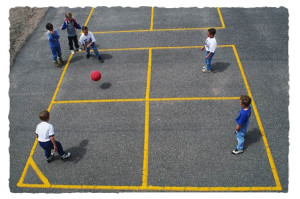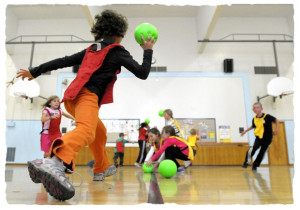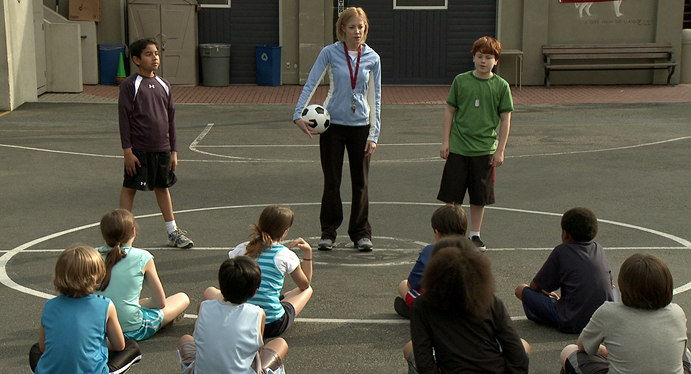What is PTPED?
Craig Valency, MA, CSCS
Millions of Americans suffer from Post Traumatic PE Disorder, or PTPED. Caused by poor physical education and a lack of purposeful fitness instruction, PTPED often begins at a young age. Although the incubation period can range from one day to several years, full-blown PTPED is long-lasting and difficult to treat. Symptoms of PTPED include:
- An overwhelming fear of looking like a buffoon while exercising
- Anxiety and panic attacks associated with physical activity
- An abnormally strong urge to remain glued to the couch
- Hatred of all team sports
- A feeling of failure in regards to physical activities, games, and fitness
- Nausea following exposure to a gym or schoolyard
- Terrifying flashbacks of dodgeballs flying at one’s face
- Persistent, negative self-talk while working out
PTPED is an Epidemic
The institutions that are entrusted with the education of our youth need to do their J-O-B. As a trainer, I deal with adults who were traumatized in PE class. They are dealing with Post Traumatic PE Disorder. The incessant drumbeat of negative self talk that I hear from clients sometimes rings louder than the music at the gym. Everyone seems to have memories of being picked last, feeling uncoordinated, being the slowest runner, or hating competition.
What’s ironic is that most of what they are saying is not true now. Most of the people I work with are actually sufficiently coordinated and run just like the rest of humanity. What messes them up is their negative associations with PE class and their lack of self-confidence. They literally talk themselves into being clumsy and uncoordinated. They feel that they are especially non-athletic. It is no wonder that so many of our fellow US citizens today are couch potatoes who have no desire to engage in physical activity, once their sentence in the forced labor PE camps is over.
Don’t believe me? Meet Christa Crawford, guest blogger, fifth grade teacher, and PTPED survivor.
My Experience with PTPED
Christa Crawford
 My first memories of PE are in first grade. I remember learning how to play 4-square. You have to hit the ball one time into another box. When someone hits it into your box, it can only bounce one time. If you let it bounce more than that, you’re out. If you hit the ball and it bounces on the line, you’re out. If you hit the ball and it bounces in your own box, you’re out. If you miss the ball when it comes flying into your box, you’re out. Out, out, out!
My first memories of PE are in first grade. I remember learning how to play 4-square. You have to hit the ball one time into another box. When someone hits it into your box, it can only bounce one time. If you let it bounce more than that, you’re out. If you hit the ball and it bounces on the line, you’re out. If you hit the ball and it bounces in your own box, you’re out. If you miss the ball when it comes flying into your box, you’re out. Out, out, out!
It took about ten seconds for me to get out. At that point, I went and stood in line for another ten minutes while I engaged in no physical activity at all. Ehh. Not so bad. At least I couldn’t get out in line.
By the time fourth grade rolled around, it was a different story. PE centered around kickball. Two team leaders were chosen, though it was always unclear why they got to be the team leaders. Of course, as the team leaders, they got to choose their teammates. Back and forth they went, picking all the best players. Jacob. Peter! Aleksey. Katherine. Ned. Darryl…. and on and on it went. At the end of the list was a mumbled “Christa.” Great! Last again. This was going to be fun.
Tyler was a great pitcher. He’d roll the ball directly to me. I felt like Indiana Jones facing the giant boulder. Frantically, I’d kick as hard as I could. Woops. Too early. The ball was only halfway to me. Okay. Try again. Just kick the ball. Once in a while, I’d get really lucky and actually make contact with the ball. “Foul!” Try again. Meanwhile, in the background, I’d hear Ryan urging me to “Kick the ball!” Thanks, Ryan. That was helpful. The second or third time, I was usually able to kick it in the right direction. As I scampered toward first, Tyler would inevitably catch it, and I was declared out. To the back of the line I’d go, where I’d stand apathetically and wonder why I was so bad at this ridiculous game.
 Once dodgeball was thrown into the mix, I started to really hate PE. What could possibly be worse than a bunch of boys slamming you in the gut with angry, mean dodgeballs? What an absolutely miserable game. To put myself out of my misery, I’d
Once dodgeball was thrown into the mix, I started to really hate PE. What could possibly be worse than a bunch of boys slamming you in the gut with angry, mean dodgeballs? What an absolutely miserable game. To put myself out of my misery, I’d throw toss a ball right at Jacob. He’d catch it with one hand, and that would get me out. I’d rather stand in line than in the middle of the battleground.
Volleyball was popular in junior high. I hated it. I couldn’t tell how far the ball was from my face as it dropped down from the sky. Again, Indiana Jones and the boulder. When I managed to get under the ball, I was never able to actually hit it over the net.
In high school, everyone was suddenly expected to be a runner. For PE, we’d either have to run three miles on the beach, or we’d run to the local college and then go up and down the stairs for an hour straight. If we weren’t at the beach or on the stairs, we were doing suicide runs. Those made me barf every single time.
I couldn’t keep up. I always felt like I was going to die. Why was I so slow? How come I couldn’t breathe? All the other girls could breathe just fine. I remember my chest caving in. I’d wheeze and try not to cry. PE gave me so much anxiety that I pulled out of my small private high school and took classes at the local college instead. I did that for a year. I then switched to a public high school where I spent 80% of my time in the choir room and the other 20% of my time learning US history. I never took another PE class again. To put it in math terms, choir > PE.
What’s ironic about all this is that I was actually good at several games. I could play hopscotch better than most of the other kids. I could jump Double Dutch while singing Miss Mary Mack, and I routinely advanced to the most advanced levels of Chinese Jump Rope. I did taekwondo three days per week. I was flexible and had a solid kick. I would surf for hours on end, even in the middle of the winter. While I might not have been ready to compete, I was at least proficient. More importantly, I was happy as a clam in the ocean. I was exercising, but it just felt like playing. I actually had a lot of endurance when I was surfing. That’s probably because I wasn’t having full-blown PE-induced panic attacks.
Unfortunately, hopscotch, jump rope, surfing, and martial arts were never part of PE. Come to think of it, there was very little coordination, agility, or balance work in PE class. Those were exactly the skills at which I excelled. No wonder I felt like a failure. PE only focused on running as fast as you could and catching, throwing, and kicking balls. What a miserable class.
As an adult, it took a lot to get myself into the gym. I had always viewed the gym as a PE torture chamber for grownups. Luckily, I had a good trainer who knew what he was doing. We do a lot of agility, balance, and reaction work. I’ve even gotten over my fear of running. I’m slowly getting over my PTPED.
Once in a while, PTPED still rears its ugly head. While lifting a heavy object over my head or sprinting on the treadmill, I sometimes start to feel my chest cave in. My face gets all red and I imagine the Indiana Jones boulder. PTPED is no joke! It’s powerful enough to keep people glued to their couches for the duration of their adult lives.
It’s criminal that year after year, PE classes are defeating their own purposes. Aside from the few naturally athletic kids in the class, many of the kids leave PE class feeling deflated, weary, and ashamed. They carry these feelings into adulthood. So many adults resent physical activity and feel like clumsy, incompetent klutzes for the rest of their lives. We wonder why America is so sedentary. We need to take a hard look at the physical education in our schools. As educators, trainers, and coaches, what are we doing to improve the situation? To find out, check out next week’s post: The Prevention and Treatment of Post Traumatic PE Disorder by Craig Valency, MA, CSCS.
Craig Valency, MA, CSCS, president and co-founder of SPIDERfit, has been a personal trainer for the last 11 years. He is currently working at Fitness Quest 10 in San Diego, an elite personal training and athletic conditioning facility. He specializes in youth strength and conditioning programs that promote physical literacy, injury prevention and optimal performance. Along with training youths from 6 to 18 years of age for general fitness, Craig has also worked with some of the top junior tennis players in the world. He has been a physical education consultant for the Stevens Point school district in Wisconsin for the last 3 years, helping revamp the district wide programming for the K-12 PE curriculum. Craig earned his bachelor degree from UCLA, and Masters Degree in Kinesiology from San Diego State University.





Connect with SPIDERfit!